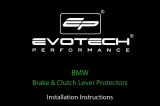
TABLE OF CONTENTS
3
10.9 Adjusting the spring preload of the
shock absorber ............................. 39
10.10 Adjusting the riding sag ................ 40
10.11 Air suspension XACT ........................ 41
10.12 Checking the basic setting of the
fork ................................................ 41
10.13 Adjusting the fork air pressure........... 42
10.14 Adjusting the compression damping
of the fork ....................................... 43
10.15 Adjusting the rebound damping of
the fork........................................... 44
10.16 Handlebar position........................... 44
10.17 Adjusting the handlebar position .... 45
11 SERVICE WORK ON THE CHASSIS............... 47
11.1 Raising the motorcycle with a lift
stand .............................................. 47
11.2 Removing the motorcycle from the
lift stand ......................................... 47
11.3 Bleeding the fork legs....................... 48
11.4 Cleaning the dust boots of the fork
legs ................................................ 48
11.5 Removing the fork protector .............. 49
11.6 Installing the fork protector............... 49
11.7 Removing the engine guard (All
XC models)...................................... 49
11.8 Installing the engine guard (All
XC models)...................................... 50
11.9 Removing the frame protector ........... 50
11.10 Installing the frame protector ............ 50
11.11 Removing the fork legs .................. 51
11.12 Installing the fork legs .................. 51
11.13 Removing the lower triple clamp .... 52
11.14 Installing the lower triple clamp ..... 53
11.15 Checking steering head bearing
play ................................................ 55
11.16 Adjusting steering head bearing
play ............................................ 55
11.17 Lubricating the steering head
bearing ........................................ 56
11.18 Removing the start number plate....... 56
11.19 Installing the start number plate........ 57
11.20 Removing front fender ...................... 57
11.21 Installing front fender....................... 58
11.22 Removing the shock absorber ........ 58
11.23 Installing the shock absorber ......... 59
11.24 Removing the seat ........................... 61
11.25 Mounting the seat............................ 61
11.26 Removing the air filter box cover ....... 62
11.27 Installing the air filter box cover ........ 62
11.28 Removing the air filter .................. 64
11.29 Cleaning the air filter and air filter
box ............................................. 65
11.30 Installing the air filter ................... 66
11.31 Preparing air filter box cover for
securing ...................................... 66
11.32 Removing the main silencer .............. 67
11.33 Installing the main silencer............... 67
11.34 Changing the glass fiber yarn filling
in the main silencer ...................... 67
11.35 Removing the fuel tank ................. 68
11.36 Installing the fuel tank .................. 70
11.37 Checking the chain for dirt................ 71
11.38 Cleaning the chain ........................... 71
11.39 Checking the chain tension ............... 72
11.40 Adjusting the chain tension............... 73
11.41 Checking the chain, rear sprocket,
engine sprocket, and chain guide ...... 74
11.42 Checking the frame ...................... 76
11.43 Checking the link fork ................... 76
11.44 Checking the throttle cable routing .... 76
11.45 Checking the rubber grip .................. 77
11.46 Adjusting the basic position of the
clutch lever ..................................... 78
11.47 Checking/correcting the fluid level of
the hydraulic clutch ......................... 78
11.48 Changing the hydraulic clutch
fluid ............................................ 79
12 BRAKE SYSTEM ......................................... 81
12.1 Checking the free travel of the hand
brake lever ...................................... 81
12.2 Adjusting the basic position of the
hand brake lever .............................. 81
12.3 Checking the brake discs .................. 81
12.4 Checking the front brake fluid level ... 82
12.5 Adding front brake fluid ................ 83
12.6 Checking that the brake linings of
the front brake are secured ............... 84
12.7 Changing the brake linings of the
front brake ................................... 85
12.8 Checking the free travel of foot brake
lever ............................................... 87
12.9 Adjusting the basic position of the
foot brake lever ............................ 87
12.10 Checking the rear brake fluid level..... 88
12.11 Adding rear brake fluid ................. 89
12.12 Checking that the brake linings of
the rear brake are secured................. 90
12.13 Changing the rear brake linings ...... 90
13 WHEELS, TIRES ......................................... 93
13.1 Removing the front wheel .............. 93
13.2 Installing the front wheel .............. 94
13.3 Removing the rear wheel ............... 94
13.4 Installing the rear wheel ................ 95
13.5 Checking the tire condition ............... 97
13.6 Checking tire pressure...................... 97
13.7 Checking spoke tension .................... 98




















